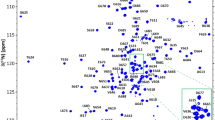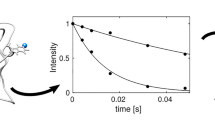Abstract
The AbrB protein is a transcription factor that regulates the expression of numerous essential genes during the cells transition phase state. AbrB from Bacillus anthracis is, nototriously, the principal protein responsible for anthrax toxin gene expression and is highly homologous to the much-studied AbrB protein from Bacillus subtilis having 85% sequence identity and the ability to regulate the same target promoters. Here we report backbone and sidechain resonance assignments and secondary structure prediction for the full-length AbrB protein from B. anthracis.


Similar content being viewed by others
References
Benson LM, Vaughn JL, Strauch MA, Bobay BG, Thompson R, Naylor S et al (2002) Macromolecular assembly of the transition state regulator AbrB in its unbound and complexed states probed by microelectrospray ionization mass spectrometry. Anal Biochem 306(2):222–227
Berjanskii MV, Wishart DS (2007) The RCI server: rapid and accurate calculation of protein flexibility using chemical shifts. Nucleic Acids Res 35(2):W531–W537
Berjanskii MV, Neal S, Wishart DS (2006) PREDITOR: a web server for predicting protein torsion angle restraints. Nucleic Acids Res 34(2):W63–W69
Bobay BG, Benson L, Naylor S, Feeney B, Clark AC, Goshe MB et al (2004) Evaluation of the DNA binding tendencies of the transition state regulator AbrB. Biochem (NY) 43(51):16106–16118
Bobay BG, Andreeva A, Mueller GA, Cavanagh J, Murzin AG (2005) Revised structure of the AbrB N-terminal domain unifies a diverse superfamily of putative DNA-binding proteins. FEBS Lett 579(25):5669–5674
Bobay BG, Mueller GA, Thompson RJ, Murzin AG, Venters RA, Strauch MA et al (2006) NMR structure of AbhN and comparison with AbrBN: first insights into the DNA binding promiscuity and specificity of AbrB-like transition state regulator proteins. J Biol Chem 281:21399–21409
Chumsakul O, Takahashi H, Oshima T, Hishimoto T, Kanaya S, Ogasawara N et al (2011) Genome-wide binding profiles of the Bacillus subtilis transition state regulator AbrB and its homolog Abh reveals their interactive role in transcriptional regulation. Nucleic Acids Res 39(2):414–428
Coles M, Djuranovic S, Söding J, Frickey T, Koretke K, Truffault V et al (2005) AbrB-like transcription factors assume a swapped hairpin fold that is evolutionarily related to double-psi β barrels. Structure 13(6):919–928
Delaglio F, Grzesiek S, Vuister GW, Zhu G, Pfeifer J, Bax A (1995) NMRPipe: a multidimensional spectral processing system based on UNIX pipes. J Biomol NMR 6(3):277–293
Goddard TD, Kneller DG (2006) Sparky 3. University of California, San Francisco
Johnson BA, Blevins RA (1994) NMR view: a computer program for the visualization and analysis of NMR data. J Biomol NMR 4(5):603–614
Phillips ZEV, Strauch MA (2001) Role of Cys54 in AbrB multimerization and DNA-binding activity. FEMS Microbiol Lett 203(2):207–210
Saile E, Koehler TM (2002) Control of anthrax toxin gene expression by the transition state regulator AbrB. J Bacteriol 184:370–380
Sonenshein AL, Hoch JA, Losick R (2002) Bacillus subtilis and its closest relatives: from genes to cells. ASM Press, Washington DC
Strauch MA, Hoch JA (1993) Transition-state regulators: sentinels of Bacillus subtilis post-exponential gene expression. Mol Microbiol 7(3):337–342
Strauch MA, Ballar P, Rowshan AJ, Zoller KL (2005) The DNA-binding specificity of the Bacillus anthracis AbrB protein. Microbiology 151(6):1751–1759
Sullivan DM, Bobay BG, Kojetin DJ, Thompson RJ, Rance M, Strauch MA et al (2008) Insights into the nature of DNA binding of AbrB-like transcription factors. Structure 16(11):1702–1713
Acknowledgments
This work is supported by a NIH grant (GM55769) and Department of Defense grant (DM090298) to JC and CM.
Author information
Authors and Affiliations
Corresponding author
Rights and permissions
About this article
Cite this article
Olson, A.L., Bobay, B.G., Melander, C. et al. 1H, 13C, and 15N resonance assignments and secondary structure prediction of the full-length transition state regulator AbrB from Bacillus anthracis . Biomol NMR Assign 6, 95–98 (2012). https://doi.org/10.1007/s12104-011-9333-2
Received:
Accepted:
Published:
Issue Date:
DOI: https://doi.org/10.1007/s12104-011-9333-2




